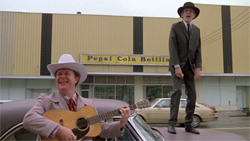From the Chicago Reader (June 1, 2002). — J.R.

Alexander Dovzhenko’s first color film and last completed feature (1948, 103 min.) was based on his play Life in Bloom, a biography (verging on hagiography) of the celebrated Russian botanist Ivan Michurin. Both the play and its screen adaptation attracted the interest of Joseph Stalin, who dictated various revisions; in fact Dovzhenko may have removed his name from the film in protest, as the credits list his wife, Julia Solntseva, as director and identify him only as the producer and screenwriter. Certain characteristic touches show up here and there — some signature landscapes, a powerful passage evoking John Ford that shows Michurin’s grief over his wife’s death — but generally this is a feel-good Stalinist biopic. Perhaps the most interesting propaganda comes in the opening scene, when a wealthy American (speaking in English) attempts to lure Michurin to the States with untold riches. In Russian with subtitles. (JR)

 Read more
Read more
From the Chicago Reader (February 1, 1988). — J.R.


Along with The Man Who Would Be King and The Dead, this is arguably John Huston’s best literary adaptation, and conceivably his very best film — a very close rendering of Flannery O’Connor’s remarkable first novel about a crazed southern cracker (a perfectly cast Brad Dourif) who sets out to preach a church without Christ, and winds up suffering a true Christian martyrdom in spite of himself. The period, local ambience, and O’Connor’s deadly gallows humor are all perfectly caught, and apart from the subtle if highly pertinent fact that this is an unbeliever’s version of a believer’s novel, it’s about as faithful a version of O’Connor’s grotesque world as one could ever hope to get on film, hilarious and frightening in equal measure. O’Connor conceived her novel as a parody of existentialism, and Huston’s own links with existentialism — as the director of the first U.S. stage production of No Exit, as well as Sartre’s Freud script — make him an able interpreter. With Harry Dean Stanton, Amy Wright, Daniel Shor, Ned Beatty, and Huston himself as the hero’s fire-and-brimstone grandfather. The producer is Michael Fitzgerald, whose family’s friendship with O’Connor guaranteed the fidelity and seriousness of the undertaking (1979). Read more
Posted on Artforum’s web site, 12/23/09. –- J.R.

Terry Gilliam’s ambitious fantasy, The Imaginarium of Doctor Parnassus, set to open in the US on Christmas Day, already did well in some parts of Europe when it premiered there in October—notably Italy and the UK, where it placed third during its opening weekends in both countries. I saw it the first time myself in Saint Andrews, Scotland, with an appreciative audience in early November. The lead character, Tony — played by the late Heath Ledger and three other actors (Johnny Depp, Jude Law, and Colin Farrell), who were called in when Ledger died halfway through the filming — is partly conceived as a spoof on Tony Blair, though one wonders whether this conceit will register with much clarity for the American audience. But it’s also unclear how much this will matter, given all the other points of attraction (such as Tom Waits as the devil and Christopher Plummer as the Methuselah-like Parnassus). Far more relevant, it seems, is the way Gilliam has ingeniously adapted the avant-garde multiple-casting ploy of everyone from Yvonne Rainer (Kristina Talking Pictures [1976]) to Todd Haynes [2007]) in terms of his own mainstream fantasy plot. Read more






